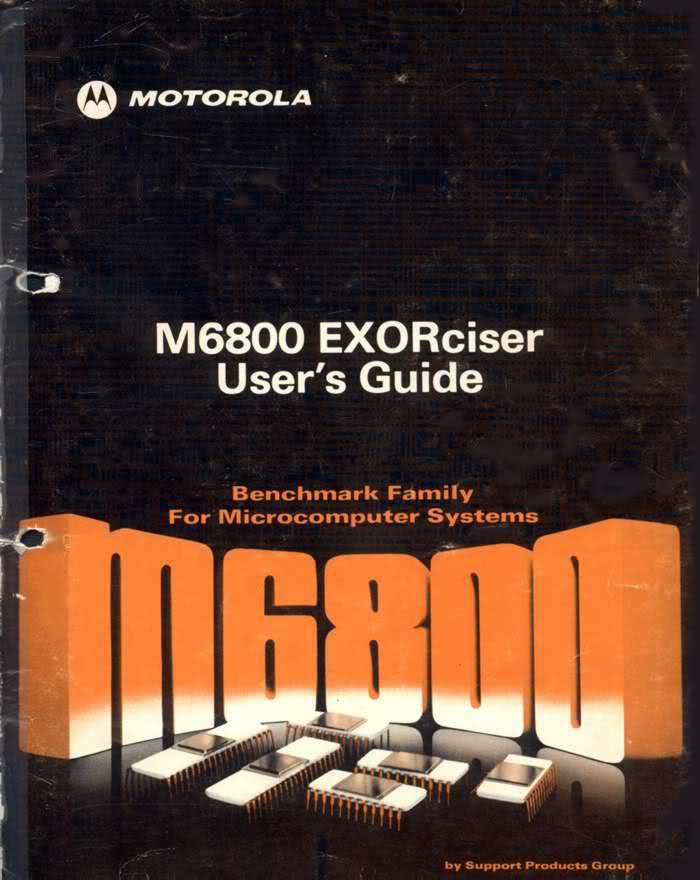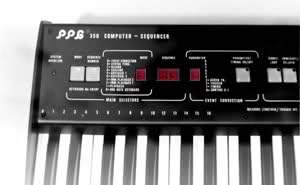The PPG Story
From a component sales representative, I had heard that microprocessors had become available and that you could do the greatest things with them (this was 1977 or '78 - at the universities, they had mainframes, but there was nothing else except electric typewriters!)
At first I couldn't imagine what to do with them, until he showed me a Motorola system. It consisted of a printed circuit board - to which you had to connect a power supply on your own - and an ASCII keyboard. The board had a video connector, to which you could connect a normal B/W TV set. If you did everything correctly, the TV screen showed: "M6800 EXORciser".
 Now you could type in little programs in machine code form and execute them. The entered code could be saved to an audio cassette. An interesting fact was that there were additional "peripheral" connectors, so that you could, for example, control switches or LEDs with it. Now I slowly realized how I could use this technology in synthesizers and sequencers. Especially for sequencers, it seemed very interesting to me, since there's not much more to them than to store and recall tones. So it came that the first product containing a microprocessor was the "PPG 350 computer sequencer".
Now you could type in little programs in machine code form and execute them. The entered code could be saved to an audio cassette. An interesting fact was that there were additional "peripheral" connectors, so that you could, for example, control switches or LEDs with it. Now I slowly realized how I could use this technology in synthesizers and sequencers. Especially for sequencers, it seemed very interesting to me, since there's not much more to them than to store and recall tones. So it came that the first product containing a microprocessor was the "PPG 350 computer sequencer".
By coincidence, I had met an old mate from my apprenticeship days: Wolfgang Kowalk, who studied informatics at the uni (today, he's professor in IT).
I could get him enthusiastic about applying his theoretical knowledge to practice, and so, along with his studies, he programmed for PPG and taught me a lot about program structure, subroutines etc.. He also convinced me that we should buy a Motorola "extension board", on which an "Assembler" was running. After I had bought that, he could really start.
The sequencer wasn't ready at the scheduled release date (just like everything at PPG), and so I had to drive to the Musicfair at Frankfurt with a barely tested prototype, where we were allowed to exhibit at the "Studio Funk" (the moog distributor, see part 3) booth.
As it showed later, the power supply in the sequencer was under-dimensioned, so that after some time, when the device warmed up, the microprocessor freaked out or the memory lost data. It was hard to cover that up at the demonstrations!
At this fair, I also got to know Ingo Werner, Reinhard Karwatky, and Armin Stöwe, who contributed lots of ideas to the further development of the later "Event Generator".
 Ich hatte von einem Bauteilevertreter erfahren, dass es nun Mikroprozessoren gibt und dass man damit die tollsten Sachen machen kann (das war 1977 oder 78 - es gab zwar an den Unis Grossrechner, aber sonst nichts ausser der elektrischen Schreibmaschine!).
Ich hatte von einem Bauteilevertreter erfahren, dass es nun Mikroprozessoren gibt und dass man damit die tollsten Sachen machen kann (das war 1977 oder 78 - es gab zwar an den Unis Grossrechner, aber sonst nichts ausser der elektrischen Schreibmaschine!).
Ich konnte mir zunächst nicht vorstellen, was ich damit anfangen sollte, bis er mir ein System von Motorola vorführte. Es bestand aus einer Platine - an die man dann selbst eine Stromversorgung anschliessen musste - und einer ASCII-Tastatur. Die Platine hatte einen Videoanschluss, an den man einen ganz normalen schwarz/weiss Fernseher anschliessen konnte. Wenn man das alles richtig gemacht hatte, erschien auf dem Bildschirm: "M6800 EXORciser".
Nun konnte man in Form von Maschinencode kleine Progrämmchen eingeben und laufen lassen. Über eine Audio-Kasette ließ sich der eingegebene code speichern. Interessant war, das es noch Anschlüsse für "Peripherie" gab, so dass man z.B. Schalter oder LEDs bedienen konnte.
Jetzt wurde mir langsam klar, wie man diese Technik in Synthesizern und Sequenzern einsetzen kann. Besonders für Sequenzer schien es mir interessant, da man ja eigentlich nur Töne speichern und wieder abrufen muss. So kam es, dass das erste Produkt, das einen Microprocessor hatte, der "PPG 350 computer sequencer" war.
 Ich hatte zufällig einen alten Kumpel aus meiner Lehrzeit wiedergetroffen: Wolfgang Kowalk, der an der Uni Informatik studierte (heute Professor für Informatik).
Ich hatte zufällig einen alten Kumpel aus meiner Lehrzeit wiedergetroffen: Wolfgang Kowalk, der an der Uni Informatik studierte (heute Professor für Informatik).
Ich konnte ihn dafür begeistern, sein theoretisches Wissen nun auch in der Praxis anzuwenden, und so hat er, neben seinem Studium, für PPG programmiert und mir viel beigebracht über Programmstruktur, Subroutines etc. Er hat mich dann auch davon überzeugt, dass wir ein "Extensionboard" von Motorola kaufen sollten, auf dem ein "Assembler" lief. Nachdem ich das dann angeschafft hatte, konnte er richtig loslegen.
Der Sequenzer wurde (wie alles bei PPG) nicht zum geplanten Termin fertig, und so musste ich mit einem kaum getesteten Prototyp zur nächsten Frankfurter Messe fahren, wo wir beim "Studio Funk" (der mit dem moog Vertrieb, part 3) auf dem Stand sein durften. Wie sich später zeigte, war das Powersupply im Sequenzer zu schwach ausgelegt, so dass immer nach einiger Zeit, wenn das Gerät warm geworden war, der Microprozessor ausflippte oder der Speicher Daten verlor. Es war schwierig, das bei den Vorführungen zu überspielen!
Auf dieser Messe habe ich auch die Bekanntschaft mit Ingo Werner, Reinhard Karwatky und Armin Stöwe gemacht, die viele Ideen zur weiteren Entwicklung des späteren "Event Generators" beigetragen haben.